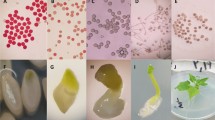Abstract
The in vitro response of ovules obtained after pollination of cotton flowers with pollen from Abelmoschus esculentus was studied. For this, 492 cotton flowers from five G. hirsutum varieties, four G. barbadense varieties and 10 F1 interspecific hybrids, were pollinated with pollen from A. esculentus and 5,069 ovules were cultured in vitro. From the cultured ovules, 69 embryos were isolated and 16 of them grew into plants. However, only three of them survived after transplantation. Finally, one plant which originated from the interspecific cross (B403 × Acala Sindos) × A. esculentus reached maturity. The mature plant (Pa0) had no morphological traits from A. esculentus. On the contrary, traits from both cotton species were observed. The flowcytometric analysis of the Pa0 plant indicated that it was hypoaneuploid. Root tip chromosome counts of its offsprings revealed a progressive chromosome increase from the Pa1 to Pa4 generation. Plants with 52 chromosomes or hypoaneuploids with a lower level of chromosomes (46–51) could be isolated from the Pa4 generation. These plants exhibited morphological traits from both cotton species and they were fertile. No signs of A. esculentus morphological characteristics were observed in these plants. It was concluded that aneuploid partial interspecific cotton plants could be produced after pollination of cotton interspecific hybrids with pollen from A. esculentus and application of an in-ovule embryo rescue technique.


Similar content being viewed by others
References
Brown MS (1947) A case of spontaneous reduction of chromosome number in somatic tissue culture of cotton. Am J Bot 34:384–388
Dolezel J (1997) Flow cytometric analysis of nuclear DNA content in higher plants. Phytochem Anal 2:143–154
Hutchinson J (1959) The application of genetics to cotton improvement. Cambridge, University Press, London
Joshi AB, Hardas MW (1976) Okra: Abelmoschus esculentus (Malvaceae). In: Simmonds NW (ed) Evolution of crop plants. New York, pp. 194–195
Mavromatis AG, Roupakias DG (1994) Biotechnology: a hope for a partial interspecific hybrid in cotton (Gossypium sp.p). In: Proc. meeting of WG Cotton Biotechnology of the FAO – International Cooperative Research Networh on Cotton, 22–23 October 1993, Leuven, Belgium, pp 29–36
Mavromatis AG, Vlachostergios DN, Roupakias DG (1998) Haploid induction in cotton: a future perspective. World Cotton Research Conferense, 6–12 September, Athens, Greece, pp 310–317
Mavromatis AG, Kantarzi SK, Vlachostergios DN, Xynias IN, Skarakis GN, Roupakias DG (2005) Induction of embryo development and fixation of partial interspecific lines after pollination of F1 cotton interspecific hybrids (Gossypium barbadense × Gossypium hirsutum) with pollen from Hibiscus cannabinus. Aust J Agric Res 56:1101–1109
Murashige T, Skoog F (1962) A revised medium for rapid growth and bio-assay with tobacco tissue cultures. Physiol. Plant 15:473–479
Saha SK, Wu J, Jenkins JN, McCarty JR, Gutierrez OA, Stelly DM, Percy RG, Raska DA (2004) Effect of chromosome substitutions from Gossypium barbadense L. 3–79 into G. hirsututm L. TM-1 on agronomic and fiber traits. J Cotton Sci 8:162–169
Stewart JMcD, Hsu CL (1977) In-ovule embryo culture and seedling development of cotton (Gossypium hirsutum L.). Planta 137:113–117
Stewart JMcD, Hsu CL (1978) Hybridization of diploid and tetraploid cottons through in ovule embryo culture. J Hered 69:404–408
Vlachostergios DN, AG Mavromatis, DG Roupakias (2000) Double haploid production in cotton (Gossypium spp). Proceedings of the Cost action 824 gametic embryogenesis final conference meeting: biotechnological approaches for utilization of gametic cells. July 1–4, 2000. Slovenia
White TG, Richmond TR, Lewis CF (1967) Use of cotton monosomes in developing interspecific substitution lines, Crops Research, ARS, 34–91, pp 3–15
Zhou S-Q (2003) Viewing the difference between the diploid and the polyploid in the light of the upland cotton aneuploid. Hereditas 138:65–72. DOI 10.1034/j.5223.2003.01689.x
Acknowledgment
Financial assistance from the Greek Secretary of Science and Technology is gratefully acknowledged.
Author information
Authors and Affiliations
Corresponding author
Rights and permissions
About this article
Cite this article
Vlachostergios, D.N., Mavromatis, A.G., Kantartzi, S.K. et al. In-vitro development of ovules obtained after pollination of cotton (Gossypium spp) flowers with pollen from okra (Abelmoschus esculentus L. Moench) . Plant Cell Tiss Organ Cult 88, 109–115 (2007). https://doi.org/10.1007/s11240-006-9178-z
Received:
Accepted:
Published:
Issue Date:
DOI: https://doi.org/10.1007/s11240-006-9178-z




